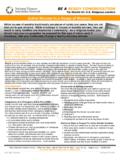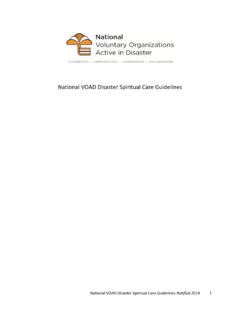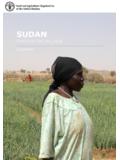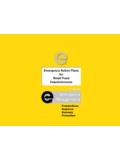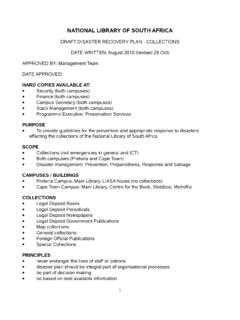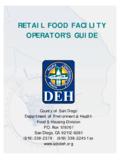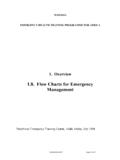Transcription of BE A READY CONGREGATION - .: National Disaster …
1 BE A READY CONGREGATION Tip Sheets for Religious Leaders National Disaster Interfaiths Network | 4 West 43rd Street - Suite 407, New York, NY 10036 | | | BUILDING Disaster RESILIENT COMMUNITIES All Rights Reserved Continued on reverse The Role of Faith Communities in Disasters UNIQUE OFFERINGS OF RELIGIOUS LEADERS AND HOUSES OF WORSHIP Comfort and Hope: In a Disaster , religious leaders are trusted caregivers to whom the majority of Americans turn for assistance and support for healing. You can offer comfort, support, clarity, and direction in times of crisis.
2 You are in a unique position to respond to people who are impacted by a Disaster because you are already trusted and in an established leadership role and you bring a faith perspective to the community s need for meaning after a Disaster . Prayer/Worship Services/Events The primary Disaster role of religious leaders is to help communities find meaning in crisis. Providing opportunities for and leading prayer/worship services provides an essential foundation for community recovery. Work with your partners to offer community-based worship services and other healing events such as anniversary commemorations. Target different audiences: youth, seniors, etc. Justice and Healing In all of your interactions, be a voice of reason and a non-anxious presence.
3 Use your connections with politicians and community leaders as well as your presence in coordinative entities and community councils to: Provide expertise on particular needs of affected populations Provide religious and cultural guidance on, and assistance in, expediting and implementing best practices, including funeral and burial services Promote efforts to curtail Disaster -related bias crimes. GENERAL TIPS TO HELP YOU DETERMINE AND PLAN FOR OTHER Disaster ROLES Ensure that your CONGREGATION has a Disaster Continuity of Operations Plan (COOP) in place and flexible. You will not be able to assist with the recovery of your community if your CONGREGATION is not prepared to protect its members, assets and programs.
4 Make sure your plan: Focuses on all hazards likely to affect your CONGREGATION Addresses how religious leaders and key staff will manage leadership if they and their families are affected Includes how to maintain essential social services that support vulnerable populations. (See NDIN Tip Sheet Continuity of Operations Planning: Ministry & Services Post Disaster ) Support your denomination or faith community s National Disaster recovery organization. (See NDIN Tip Sheet National Faith-Based Disaster Service Organizations or the NVOAD website for a list of member faith-based Disaster recovery organizations: ) If your house of worship is considering short-term recovery roles, do your homework.
5 Learn about the services that major Disaster leaders like the American Red Cross, The Salvation Army and FEMA provide, and consider partnering with them. Take FEMA s Independent Study course, The Role of Voluntary Agencies in Emergency Management. Think long-term. There is always a tendency for Disaster recovery organizations (including faith-based) to spend too much, too early. Even at the beginning of the recovery process, plan for supporting the long-term unmet needs of victims. Local organizations will still be doing recovery work long after the response agencies have moved on. Become involved with local community and Disaster networks: Citizen Corps Council, Disaster interfaith, state or local VOAD. Build on your strengths.
6 If your CONGREGATION already has effective community outreach or service programs, focus your energy on expanding your core competencies, , clothing distribution, feeding program, 12-step, sheltering. Consider which populations you are uniquely positioned to serve, , specific religious, ethnic, cultural, or age groups. Integral to all phases of the Disaster lifecycle are the support and services provided by congregations and faith-based social service and Disaster programs. For instance, the backbone of mitigation education and preparedness training for all relief and long-term recovery operations is the work of religious organizations collaborating as interfaith or faith-based networks. TIP SHEET 04 TS4 The Role of Faith Communities in Disasters ( ) National Disaster Interfaiths Network | 4 West 43rd Street - Suite 407, New York, NY 10036 | | | BUILDING Disaster RESILIENT COMMUNITIES All Rights Reserved GENERAL TIPS TO HELP YOU DETERMINE AND PLAN FOR OTHER Disaster ROLES (continued) Be aware of conduct protocols.
7 Orient yourself to the ethics of working with a traumatized community. It is commonly considered unethical to proselytize when doing Disaster work. Educate your staff and volunteers about the language, cultural, and religious practices and needs of the community you seek to serve. Develop written agreements with partners. Organizations doing similar or complementary work to yours can be crucial partners. Memoranda of Understanding (MOU s) serve to outline accountability, operational guidelines, and responsibilities that can be used to manage operations under circumstances where communication is limited and decision makers are unavailable. MOU s are a critical tool for operational partnerships. Ensure your programs are available to all.
8 Consider the needs of people with disabilities, seniors, and non-English speakers. Aim to provide physical access for those who use wheelchairs and walking aids, provide materials in alternate formats, and gain the trust of and communicate information to specific communities. Be flexible. What is written into your plan may not be what is needed during a particular Disaster . Plans are best thought of as guidelines and preferred best practices; assume that nothing may go as planned; be prepared to improvise. SUGGESTED MITIGATION & PREPAREDNESS ROLES Know the hazards your community is most vulnerable to and take steps to mitigate their impact on your CONGREGATION your members, physical plant and operations. Partner with local networks to educate your CONGREGATION and community about all-hazards to which they are vulnerable and plan, practice/drill and train to mitigate the impact of those hazards.
9 Train to volunteer with local response programs: American Red Cross: Citizen Corps Council: Your local Disaster chaplaincy network Your local Disaster interfaith Your local volunteer center Medical Reserve Corps: The Salvation Army: Participate in Disaster advocacy. Support legislation and local laws that promote individual recovery. Promote tolerance and build a more Disaster -resilient city by helping to prevent post- Disaster bias crimes. (See NDIN Tip Sheet Disaster Backlash: Bias Crimes & Mitigation. ) SUGGESTED RESPONSE & RECOVERY ROLES Offer your facilities. Facilities of all sizes and make-ups can be used in many ways during disasters, as assistance centers, dorms for volunteers, shelters and warehouses.
10 (See NDIN Disaster Tip Sheet How to Use Your House of Worship in a Disaster . ) Short-term recovery services. Home clean-up, child-care, and food services are just a few of the ways you can assist. Following a Disaster , many relief agencies are looking for congregations to organize teams of volunteers and respond to clean-up and recovery needs as they emerge. Encourage volunteering to support existing programs (including programs listed here). Volunteers should affiliate with an organization before a Disaster . Look into agencies such as your denomination s or faith community s recovery agencies and their local operations, as well as local programs of the Salvation Army and the American Red Cross. Disaster Chaplaincy: NDIN offers Disaster Chaplaincy training and services for faith communities throughout the , and we support and work with local Disaster chaplain or spiritual care providers.



